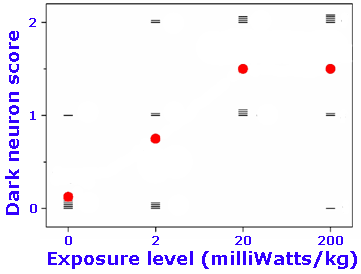Salford, LG, AE Brun, JL Eberhardt, L Malmgren and BRR Persson.
Nerve cell damage in mammalian brain after exposure to microwaves from GSM mobile phones
What did they find? As expected, both control and experimental animals had albumin within the hypothalamus. This is normal. A closer look shows things far from normal!

Exposed animals (Right), however, were much more likely to have albumin leaking from blood vessels in inappropriate locations. Control animals, (not exposed) in contrast, showed either no albumin leakage or occasional isolated spots, as seen in the actual picture on the left. A closer look at the cells within the brain revealed that exposed animals had “scattered and grouped dark neurons… often shrunken.. with loss of internal cell structures.” These altered neurons were seen in all locations, but “especially the cortex, hippocampus and basal ganglia.”
A word of caution? Research on rats suggests that heavy use of mobile phones may put people at risk for neuronal damage.
The idea that frequent exposure to electromagnetic fields (EMFs) generated by mobile phones could cause adverse health effects has taken on the status of urban myth in many people’s minds due to the lack of definitive scientific evidence. But startling new findings by a team of researchers from Lund University in Sweden make the issue once again a cause for genuine concern–and suggest it might be time to get serious about using your headset when talking on your mobile phone and encouraging your family members to do the same
Salford et al. document serious neuronal damage in rat brains following exposure to microwave radiation from a cell phone, at levels comparable to what people would experience during normal use. Damage to nerve cells was observed in several places within the brain, including the cortex, hippocampus, and basal ganglia. It was associated with evidence of leakage of proteins through the blood-brain barrier. The authors express concern that “after some decades of (often) daily use, a whole generation of [cell phone] users may suffer negative effects, perhaps as early as middle age.”
In a companion news story in the issue of Environmental Health Perspectives in which the research is published, the journal comments: “It might be time to get serious about using your headset when talking on your mobile phone and encouraging your family members to do the same.”
What did they do? Salford et al. exposed rats to microwave radiation from a GSM cell phone, varying the intensity of radiation across a range that would be experienced by mobile phone users. The rats were contained within plastic trays inside a specially constructed wooden box that allowed free movement, other than to prevent direct contact with the source of radiation. One set of animals was placed in the box without turning on the transmitter; they served as a control group. The others were exposed to peak power densities of 0.24, 2.4, and 24 Watts/square meter (which translates to 2 milliWatts per kg, 20 mW/kg, and 200 mW/kg, respectively). Each group contained 8 animals.
After a 50-day waiting period, during which the rats were monitored for behavioral abnormalities, Salford et al. killed the animals, carefully removed their brains, and studied them by applying stains and albumin antibodies that allowed detection of abnormalities.
Salford and his colleagues scored the rat brains for the number of dark neurons. They observed that higher exposures produced more dark neurons
 The number of small horizontal bars indicates the number in each treatment group with a given score. All treatment groups differed significantly from the control group.
The number of small horizontal bars indicates the number in each treatment group with a given score. All treatment groups differed significantly from the control group.
Adapted from Salford et al.
What does it mean? Most of the public debate about the possible health effects of microwave radiation from cell phones has focused on cancer. While debate about this continues, most studies, including by Salford’s research team, have had negative results.
This work focuses on a different mechanism that had been identified by earlier authors (e.g., Oscar and Hawkins 1977) but not pursued vigorously: increased permeability of the blood-brain barrier. These results clearly establish an adverse impact at levels within the range experienced by people using cell phones.
According to these scientists, “intense use of mobile phones by youngsters is a serious consideration. A neuronal damage of the kind described here may not have immediate, demonstrable consequences, even if repeated. In the long run, however, it may result in reduced brain reserve capacity that might be unveiled by other later neuronal diseases or even the wear and tear of aging. We cannot exclude that after some decades of (often) daily use, a whole generation of users may suffer negative effects, perhaps as early as in middle age.”
That is a cautious way of saying that Salford and his team of scientists are very concerned about the possible human impacts of cell phone use. Indeed, as noted above, the journal in which these results were published, Environmental Health Perspectives (the journal of the National Institute of Environmental Health Sciences)







